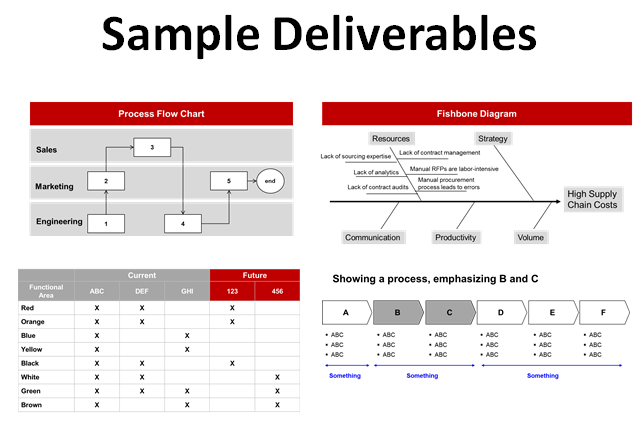A statement of work (SOW) is a phrase you will hear almost daily in your life as a consultant. It’s the contract with the client on what you will be done and how much they will pay. Basically, it’s the lifeblood of a firm’s utilization, profitability, and career advancement. Consultants sell services and the SoW is the purchase order.
Use a common structure
This should be fairly predictable – this is not where you want to get overly creative. Stick to something like this: introduction, background, objective, approach, scope of services, milestones, references, resources, dependencies, fees, conclusion. You can Google “SOW samples pdf” and you should get plenty of examples.
The SOW answers the top questions the client has about the project:
- What will I get (deliverables) at the end?
- Who will you bring to do the work? What is the staffing leverage?
- How much will it cost? What are the payment terms?
- How will the work be done? What are the key activities?
- How long will the project take? How many weeks on-site, off-site?
- How will quality be measured? Are there performance measures?
Provide “just enough content”
There are likely differing opinions on this, but from my vantage point, you want to only add just enough detail. Not too much, not too little. It needs to be like Goldilocks’ porridge – just right for the reasons below:
- Enough so that the client knows what they are buying
- Enough so the client is willing to “buy the work” – sell baby sell
- Enough that your teams are clear on the goal and expectations
- Nothing more
The last thing you want to do is be half-way through a project and be handcuffed to unnecessary crap you put in the SoW by accident. Don’t force your future self to do busy-work which is not core to the mission.
I believe all change management – most everything in life – is part intellectual, part emotional, and part action. Head, Heart, Hand. Same is true with clients who are buying consulting services.
Set the tone
Naturally, the level of familiarity will vary on both the industry and your relationship with the target audience. As a stereotype, I would imagine IT security services would be very buttoned-up, while marketing or leadership workshop would be much looser, visual and creative.
Avoid jargon. Don’t be a consulting stereotype. Speak and write clearly.
If you can’t explain it simply, you don’t understand it well enough – Albert Einstein
Writers – yes, even proposal writers – like to add their personal touches and style. Some SoW are boring, others are not. Add what you will, but remember that style probably matters maybe 5-10%? Don’t over do it.
Create visual appeal
In consulting, I find that graphs, tables, and mock-ups help. It gives the buyer a mental picture of what they are getting. There is also a chance for you to re-purpose some of the PowerPoint you probably used during the last client meeting or oral presentations. You will laugh, but it is common to see shrunk down photos of sample deliverables like mini Legos arranged on the floor. For example:

Don’t reinvent the wheel
No surprise – a lot of SOWs are on the same type of work. There is no reason to rewrite everything. As the adage goes,’ if it’s not broke don’t fix it.’ Many of us are tempted to simply copy and paste from a previous SOW and then find / replace the client name. Danger. Danger. A few cautionary thoughts on that:
- Make sure you find all versions of the client name. (e.g., Vermont Technical College, VTC, VT, Vermont)
- Have someone else proof-it. Word by word.
- Add enough detail that it’s not generic, flat, and dehumanizing.
- Don’t get caught with copy/paste. Consultants already have the reputation for being a bit lazy.
Keep it tight
This goes without saying, but make the SOW very professional, logical, consistent, and brief. It is very common to have multiple people work on different sections of the SOW and piece it together at the last minute like Frankenstein. There are a lot of dangers in that, as you might imagine. To prevent a Franken-SOW:
- Watch version control. Hundreds of hours are lost by people duplicating work or losing track of changes
- Have 1 person go through the document to make sure all the fonts, font size, acronyms, bullets, graphic colors, page numbers, links, indentations – yes, everything – is absurdly consistent
- Have 1 person go and round-out the language so it reads as if it were written by 1 person. I am sure you can read copy-writing blogs on this topic, but the saddest thing is a presentation or proposal which is obviously cobbled together by multiple people. Amateur
Demonstrate expertise, succinctly
In all proposals and SOWs, there is a little bit of mandatory show-boating at the beginning. Examples of where you have done the work before, how your provocative point of view differs from the mass-market, and the reasons they should hire you. As a good marketer = your job is to make it easy to understand, and more importantly, easy to buy. Remember, simplify your arguments.
Know the client
If you have worked before at the client – mention it. Whatever insights you have about the client’s specific situation puts you 1 step ahead of the competition. B2B customers (read: clients) are always afraid they will hire the wrong people, get embarrassed, or lose control of the project. Your job is to show your knowledge, intimacy and trust.
Use specifics
What can you pull from the annual report, company magazine, local news articles, or your oral presentation to add some local flavor? One partner wisely said, “specificity lends credibility.” I type up meeting minutes from all my client encounters, and its amazing how much content that gives you for SOW. As another partner once said, “when you repeat back to the client what they said, they think you are a genius.” Sad but clearly 25% true, I think.
Expect scrutiny
SOWs are a part of a legal contract. They often have terms and conditions at the back. The document will be read by many people on the client side – and should be reviewed by both legal departments. Avoid vague language or your legal department will hammer you with revisions.
Foreshadow future work
No consultant wants to do 1 project with a client and leave. There is always more work to do. Phase 2. Phase 3. Implementation. If you see this work within a larger context (of course it does) – then allude to that.
Have a call to action
Like most B2B purchasing cycles, clients don’t buy the first time they see something. It takes customization, group-purchasing discussion, alignment with the budgeting cycle, and ultimately, time. As difficult as it seems – you need to motivate the reader of the SOW to take some action – forward to other “approvers”, call you for a presentation, or even better, sign the $%$@& SOW and get it started.
Practice writing SOWs
Senior managers are the work-horses of SOW and proposal writing. Wherever you are in the consulting pyramid, you better get good at pitching in and creating winning Statements of Work. If not, eventually, you will get voted off the island. As (senior) consultants do the industry research, proof-read, find previous SOWs and scrub them. As (senior) managers come up with the project scope, resourcing, pricing, deliverables, and final SOW. As partners and principals, be responsible for everything and make it happen.
Related posts:
5 Consulting Courses
Available on Coursera

Yes, I’ve spent months in the studio, recording 5 courses for Coursera.
I’d like to share my experiences and advice on how we can all work like consultants; smarter and faster.
SOW discussed in #5 course.
You can audit the classes for free, or pay to get the full experience and certification.
Click any of the buttons.

Great article – and timely. I was just asked for a “summary” that describes how I would deliver my services and what the client can expect. Have you seen summaries used in place of SoW’s? I have used SoW’s in previous work, but have never been asked for a summary. The request came from an experienced person in a very large company. Are these terms used interchangeably?
Fascinating. Frankly, I would ask him/her what they would like to see in the “summary”. If it is the first time, definitely would err on the side of more formal and more detailed and let them be the one to tell you it’s not needed.
I have had a client ask for a 1pager ppt summary etc, that they planned to forward to other people – so those folks would not have to read the whole SOW. However, that was a client I had an established rapport and finished multiple projects.
Net/net: SOW and summary are not synonymous in my book. A “summary” will not help you collect payment at the end of the project.
Thanks. I’ll take your advice and produce a SoW. If its too much then I can peel it back. Your advice on the payment is good – it would be awkward to produce a summary and then later produce a SoW that wasn’t aligned.. That’s a great point.
Yep, keep trucking. Let me know how it turns out.
Nice post. A useful follow-up would be an explanation of the MSA and the relationship between the two.
Very true. Honestly, that is something I will have to really think on. In my experience the MSA / SOW “relationship” has created confusion, hurt feelings, and lots of he said/she said. Will see. Thanks for the idea plant.
I have two remarks:
1. You mentioned “assumptions” as part of SoWs. I did this till now and realized, it’s wrong. We take them over from estimations. In a SoW we should call them what they are: dependencies. This is a much more legal term and gives you a whole lot of leverage, e.g. when timelines are not met at the client side.
2. Speaking of MSAs: An important thing in a SoW is emphasizing where it deviates from the MSA, e.g. when you exclude warranty.
Bastian. Huge fan of your comment. Will add to the body of my post later tonight.
To clarify, is the SoW created in Powerpoint? I have only seen them in Word documents but from the article it seems like you provide them in a PPT format.
Thanks,
Hello VJ,
You are right. I think 100% of the SoW I have written are in MS Word. Have to re-read my post, see where that might have looked like PPT. You are right, MS Word – all the way.